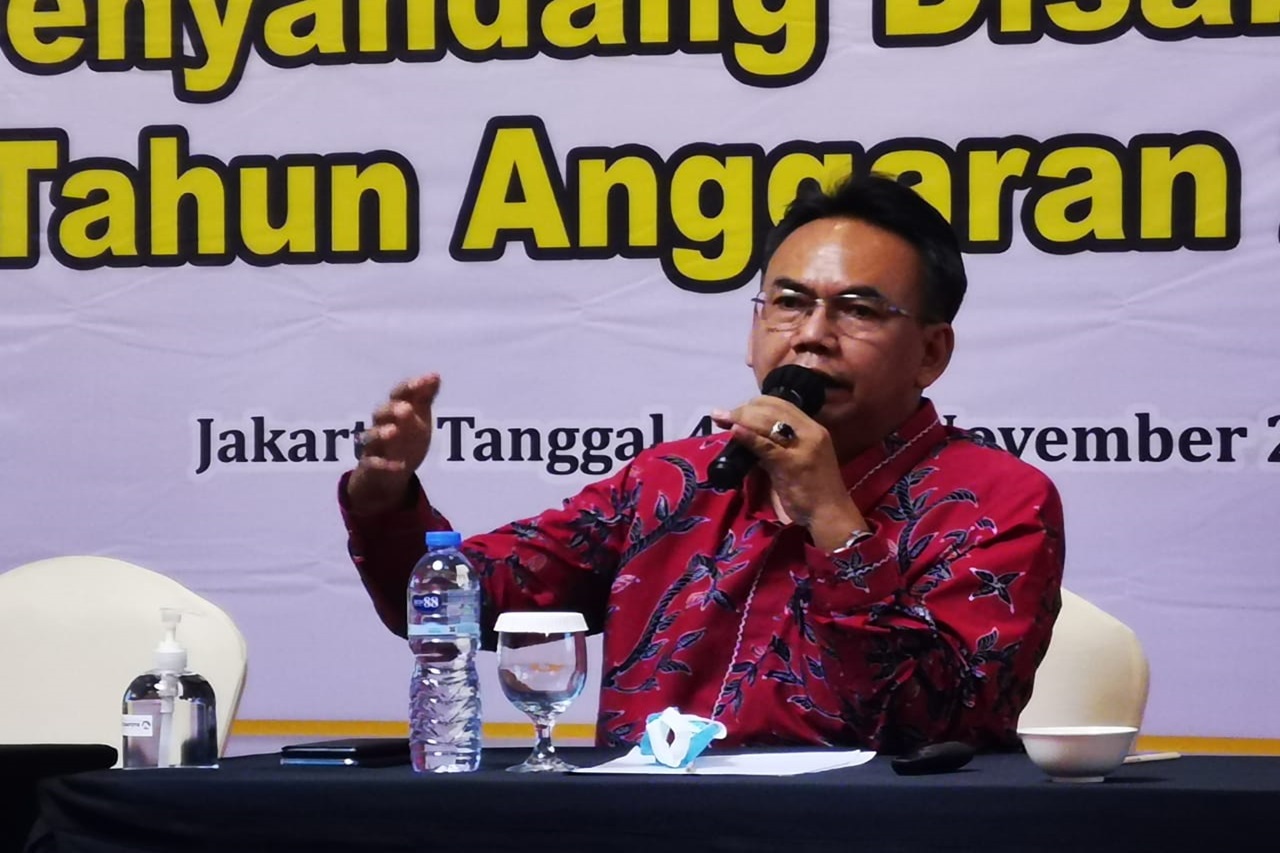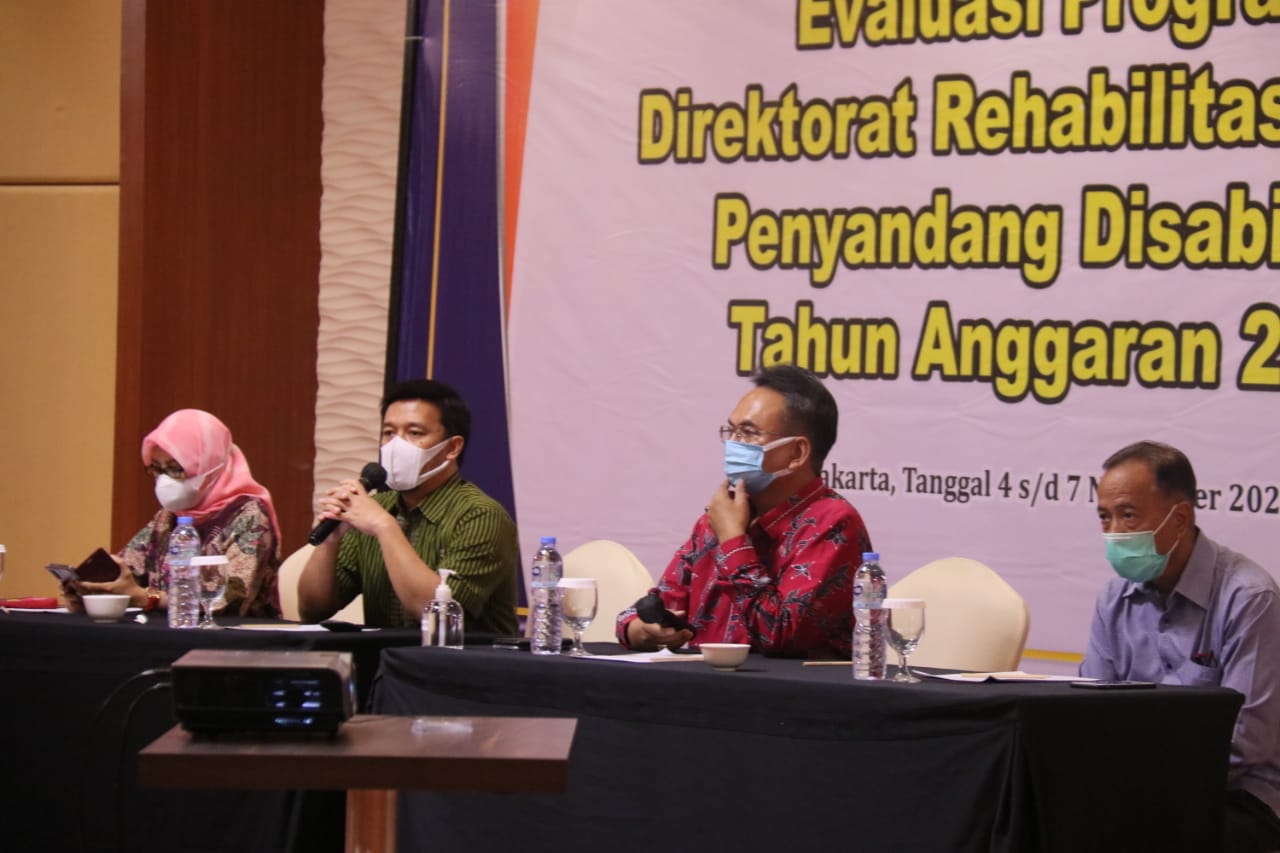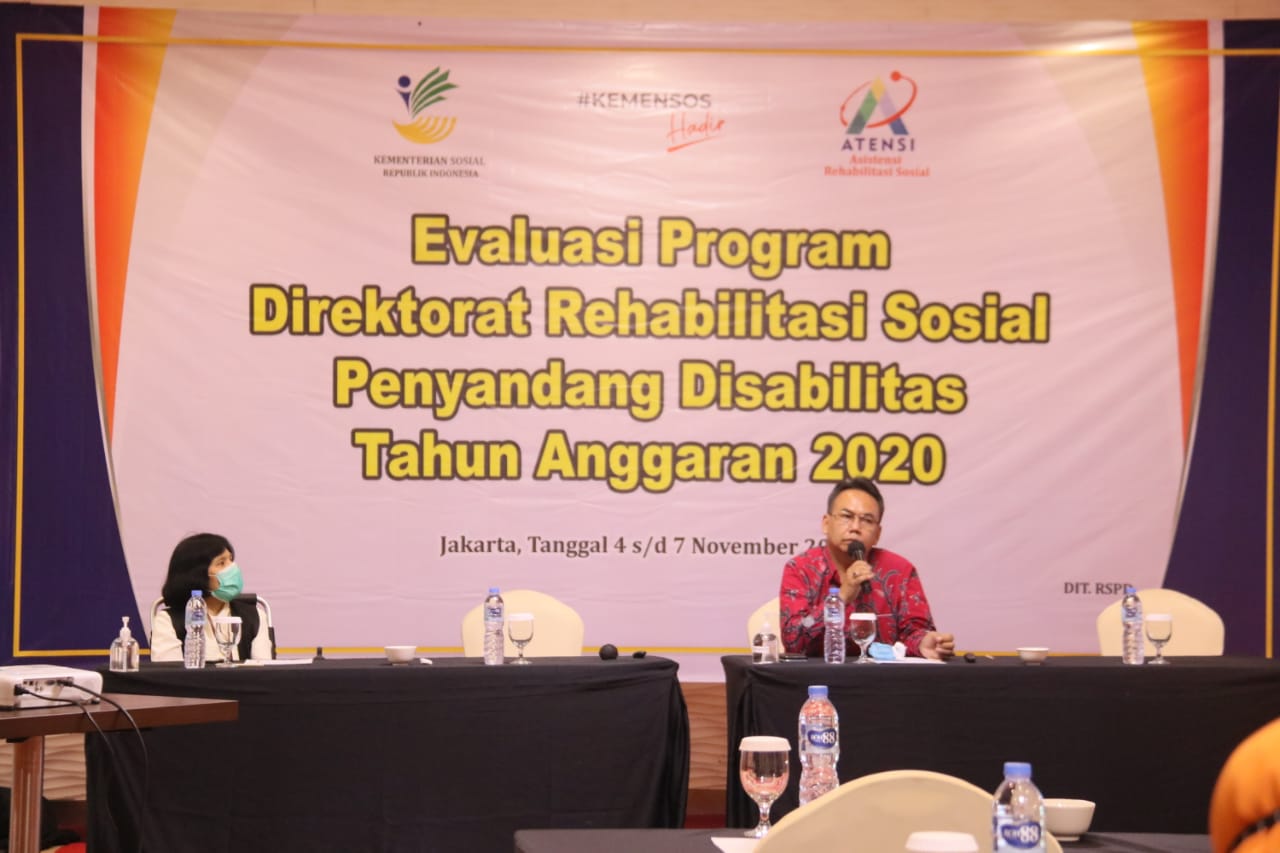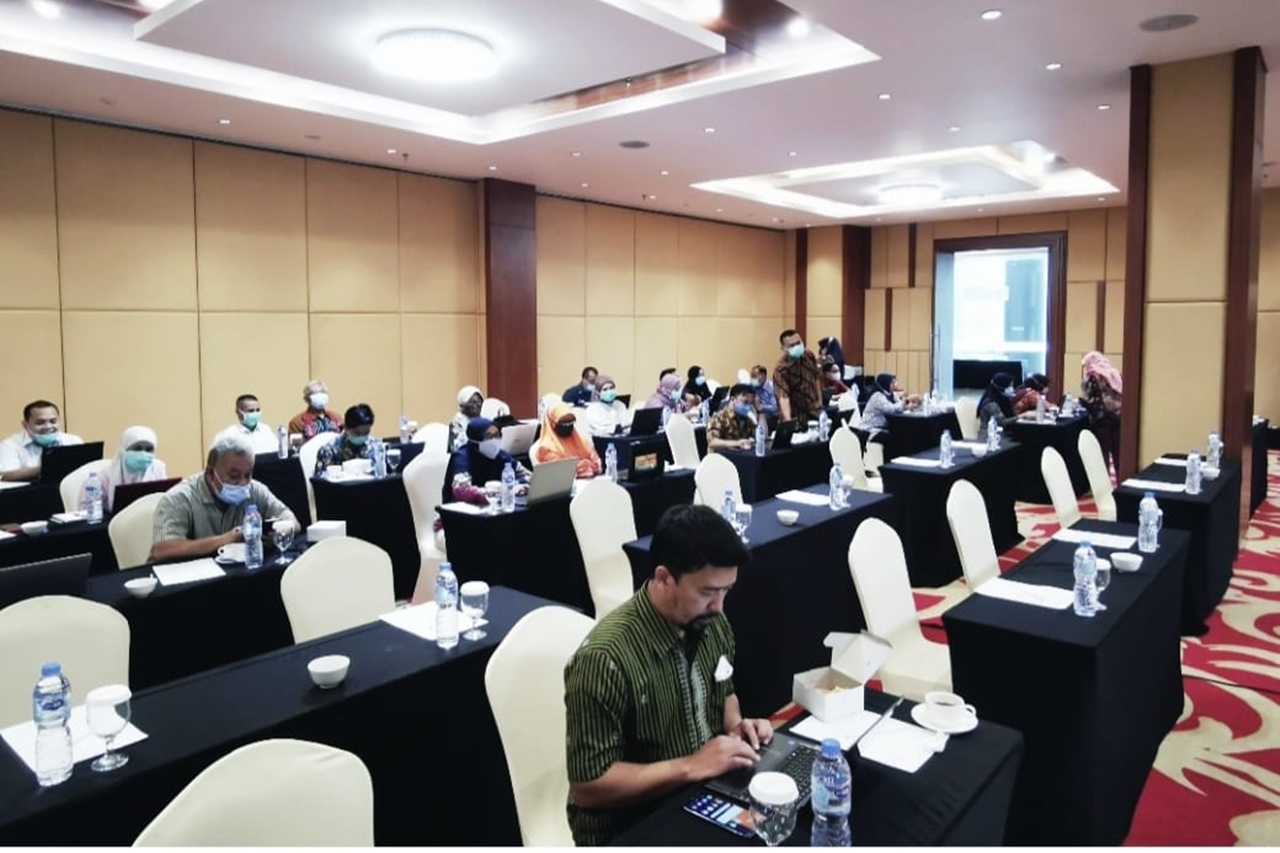Writer :
Humas Dit. Penyandang Disabilitas
Editor :
Annisa YH
Translator :
Intan Qonita N
BEKASI (November 5, 2020) - Evaluation of the Social Rehabilitation Program for Persons with Disabilities is a strategic and main activity for the Directorate General of Social Rehabilitation and the Social Rehabilitation Center for Persons with Disabilities. Evaluation as an important program to review or assess the success of the program which includes the input, process, output and outcome of the social rehabilitation program.
For this reason, the Director General of Social Rehabilitation of the Ministry of Social Affairs, Harry Hikmat, requested that the ranks of the Directorate of Social Rehabilitation of Persons with Disabilities and its Technical Implementation Unit (UPT) understand and master standardized social rehabilitation evaluation techniques. Harry reminded that the evaluation carried out was oriented towards change.
"The Ministry of Social Affairs has a differentiation between the directorate (central) and the Social Rehabilitation Center (regional). The Directorate is an institution that implements national programs with indirect service. Meanwhile, the Social Rehabilitation Center through new branding of social services, starting in 2020, will carry out direct services, namely Social Rehabilitation Assistance (ATENSI) for Persons with Disabilities Disabilities" Harry explained.
The Director General of Social Rehabilitation added that the Directorate of Social Rehabilitation of Persons with Disabilities as a support system acts as a support system so that ATENSI for Persons with Disabilities can be carried out effectively and efficiently. One of the important components of the directorate is to carry out supervision, monitoring and reporting.
"Monitoring should be carried out continuously in every stage of the program to ensure that every stage of the program can be implemented. If it is not in accordance with the program or plan, immediately analyze factors and obstacles and follow up on the results of the monitoring. Even through the current technology information system, the results of monitoring must be monitored in real time because the data is volatile and dynamic in the form of a dashboard," said Harry.
As a follow-up to the monitoring is an evaluation which is an assessment of the quality and achievements of program implementation supported by indicators, parameters and norms. "One indicator, for example, is the percentage of beneficiaries who are able to do Activity Daily Living (ADL). The parameters for each person with a disability are different," said Harry.
"For example, people with intellectual disabilities before the habilitation process have not been able to interact with other people. They just show a blank stare and smile to themselves so it doesn't create a positive relationship. However, after participating in various therapies as social rehabilitation packages they have progress in interacting to understand the messages conveyed in communication. Norms will be formed when they have fulfilled the requirements in communication," he added.
For this reason, the Director General of Social Rehabilitation of the Ministry of Social Affairs, Harry Hikmat, requested that the ranks of the Directorate of Social Rehabilitation of Persons with Disabilities and its Technical Implementation Unit (UPT) understand and master standardized social rehabilitation evaluation techniques. Harry reminded that the evaluation carried out was oriented towards change.
"The Ministry of Social Affairs has a differentiation between the directorate (central) and the Social Rehabilitation Center (regional). The Directorate is an institution that implements national programs with indirect service. Meanwhile, the Social Rehabilitation Center through new branding of social services, starting in 2020, will carry out direct services, namely Social Rehabilitation Assistance (ATENSI) for Persons with Disabilities Disabilities" Harry explained.
The Director General of Social Rehabilitation added that the Directorate of Social Rehabilitation of Persons with Disabilities as a support system acts as a support system so that ATENSI for Persons with Disabilities can be carried out effectively and efficiently. One of the important components of the directorate is to carry out supervision, monitoring and reporting.
"Monitoring should be carried out continuously in every stage of the program to ensure that every stage of the program can be implemented. If it is not in accordance with the program or plan, immediately analyze factors and obstacles and follow up on the results of the monitoring. Even through the current technology information system, the results of monitoring must be monitored in real time because the data is volatile and dynamic in the form of a dashboard," said Harry.
As a follow-up to the monitoring is an evaluation which is an assessment of the quality and achievements of program implementation supported by indicators, parameters and norms. "One indicator, for example, is the percentage of beneficiaries who are able to do Activity Daily Living (ADL). The parameters for each person with a disability are different," said Harry.
"For example, people with intellectual disabilities before the habilitation process have not been able to interact with other people. They just show a blank stare and smile to themselves so it doesn't create a positive relationship. However, after participating in various therapies as social rehabilitation packages they have progress in interacting to understand the messages conveyed in communication. Norms will be formed when they have fulfilled the requirements in communication," he added.
The indicators of social rehabilitation programs for Persons with Disabilities are according to their type, namely Persons with Physical Disabilities, Persons with Mental Disabilities, Persons with Sensory Disabilities, Persons with Intellectual Disabilities and Persons with Multiple Disabilities. "To optimize this step, the Ministry of Social Affairs immediately standardizes monitoring and evaluation and reporting for persons with disabilities, including 19 UPTs of Social Rehabilitation Center for Persons with Disabilities through a monitoring system," said Harry.
On this occasion, the Director General of Social Rehabilitation reaffirmed that the objectives of the social welfare program for Persons with Disabilities are to fulfill their basic needs and rights, carry out their social duties and roles, and overcome problems in their lives.
"This goal can be measured from the specific goals of the program, for example, increasing beneficiaries who can meet basic needs can be measured by the ability to do ADL, self-actualization ability and ability to return to the family. However, it must also be accompanied by the ability of beneficiary families in carrying out care, care and their social protection," said Harry.
If the social welfare program for Persons with Disabilities is community-based through the Social Welfare Institution (LKS), then monitoring and evaluation must also be carried out to measure the ability to implement ATENSI and be accompanied by an increase in human resources. "Because ATENSI is a social rehabilitation service that uses a family-based, community and/or residential approach in a dynamic, integrative and complementary way," said Harry.
The "Logical Framework" of ATENSI to Persons with Disabilities includes the fulfillment of a decent life, nurture and care, family support as well as physical, psychosocial, and mental spiritual therapy. Furthermore, vocational training and entrepreneurship coaching, social assistance and assistance as well as accessibility support," he explained.
The importance of monitoring and evaluation in program implementation is reinforced by a statement from the Inspectorate General of the Ministry of Social Affairs for Social Rehabilitation, Suzanti Nathalia who conveyed the results of the evaluation of the social rehabilitation program for Persons with Disabilities in 2020. "The Government Internal Control System (SPIP) is effective in managing state finances related to existing program policies," said Susanti.
Suzanti also said that the implementation of ATENSI for Persons with Disabilities must pay attention to the use of the budget, administration and reporting, including the 19 UPTs of Social Rehabilitation Centers for Persons with Disabilities.
On this occasion, the Director General of Social Rehabilitation reaffirmed that the objectives of the social welfare program for Persons with Disabilities are to fulfill their basic needs and rights, carry out their social duties and roles, and overcome problems in their lives.
"This goal can be measured from the specific goals of the program, for example, increasing beneficiaries who can meet basic needs can be measured by the ability to do ADL, self-actualization ability and ability to return to the family. However, it must also be accompanied by the ability of beneficiary families in carrying out care, care and their social protection," said Harry.
If the social welfare program for Persons with Disabilities is community-based through the Social Welfare Institution (LKS), then monitoring and evaluation must also be carried out to measure the ability to implement ATENSI and be accompanied by an increase in human resources. "Because ATENSI is a social rehabilitation service that uses a family-based, community and/or residential approach in a dynamic, integrative and complementary way," said Harry.
The "Logical Framework" of ATENSI to Persons with Disabilities includes the fulfillment of a decent life, nurture and care, family support as well as physical, psychosocial, and mental spiritual therapy. Furthermore, vocational training and entrepreneurship coaching, social assistance and assistance as well as accessibility support," he explained.
The importance of monitoring and evaluation in program implementation is reinforced by a statement from the Inspectorate General of the Ministry of Social Affairs for Social Rehabilitation, Suzanti Nathalia who conveyed the results of the evaluation of the social rehabilitation program for Persons with Disabilities in 2020. "The Government Internal Control System (SPIP) is effective in managing state finances related to existing program policies," said Susanti.
Suzanti also said that the implementation of ATENSI for Persons with Disabilities must pay attention to the use of the budget, administration and reporting, including the 19 UPTs of Social Rehabilitation Centers for Persons with Disabilities.
"Monev must be carried out because it can be used as the basis for formulating program policies in 2021. Then, a joint commitment is needed in realizing financial accountability," he added.
The activity organized by the Directorate of Social Rehabilitation for Persons with Disabilities was attended by 45 employees from November 4-7, 2020 at Avenzel Hotel and Convention Bekasi. Through this evaluation activity, it will be known the level of success and obstacles as well as the synergy of efforts to improve and improve quality in the implementation of the Social Rehabilitation Program for Persons with Disabilities.
The activity organized by the Directorate of Social Rehabilitation for Persons with Disabilities was attended by 45 employees from November 4-7, 2020 at Avenzel Hotel and Convention Bekasi. Through this evaluation activity, it will be known the level of success and obstacles as well as the synergy of efforts to improve and improve quality in the implementation of the Social Rehabilitation Program for Persons with Disabilities.
Share :
 English
English
 Bahasa
Bahasa




